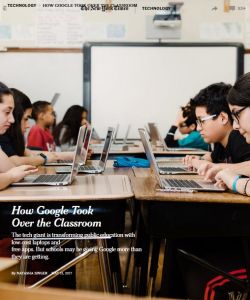
Article
How Google Took Over the Classroom
The tech giant is transforming public education with low-cost laptops and free apps. But schools may be giving Google more than they are getting.
The New York Times,
2017
auto-generated audio
1×
Log in to listen to the audio summary.
auto-generated audio
Recommendation
Classrooms across the United States are rapidly becoming “Googlified.” About half of all American primary and secondary-school students today use Google Chromebooks at school. New York Times technology reporter Natasha Singer explains that a crucial ingredient of Chromebook’s success is the unconventional way Google markets the product and tailors its services to the needs of teachers. getAbstract recommends Singer’s in-depth look at how Google has conquered American classrooms and examines the implications for educators and marketing professionals.
Summary
About the Author
Natasha Singer is a technology reporter who covers digital learning and consumer privacy for The New York Times.








Comment on this summary